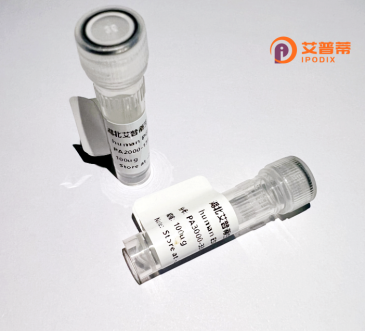
| 纯度 | >90%SDS-PAGE. |
| 种属 | Human |
| 靶点 | POU3F2 |
| Uniprot No | P20265 |
| 内毒素 | < 0.01EU/μg |
| 表达宿主 | E.coli |
| 表达区间 | 1-443 aa |
| 活性数据 | MATAASNHYS LLTSSASIVH AEPPGGMQQG AGGYREAQSL VQGDYGALQS NGHPLSHAHQ WITALSHGGG GGGGGGGGGG GGGGGGGGDG SPWSTSPLGQ PDIKPSVVVQ QGGRGDELHG PGALQQQHQQ QQQQQQQQQQ QQQQQQQQQR PPHLVHHAAN HHPGPGAWRS AAAAAHLPPS MGASNGGLLY SQPSFTVNGM LGAGGQPAGL HHHGLRDAHD EPHHADHHPH PHSHPHQQPP PPPPPQGPPG HPGAHHDPHS DEDTPTSDDL EQFAKQFKQR RIKLGFTQAD VGLALGTLYG NVFSQTTICR FEALQLSFKN MCKLKPLLNK WLEEADSSSG SPTSIDKIAA QGRKRKKRTS IEVSVKGALE SHFLKCPKPS AQEITSLADS LQLEKEVVRV WFCNRRQKEK RMTPPGGTLP GAEDVYGGSR DTPPHHGVQT PVQ |
| 分子量 | 46.8 kDa |
| 蛋白标签 | His tag N-Terminus |
| 缓冲液 | PBS, pH7.4, containing 0.01% SKL, 1mM DTT, 5% Trehalose and Proclin300. |
| 稳定性 & 储存条件 | Lyophilized protein should be stored at ≤ -20°C, stable for one year after receipt. Reconstituted protein solution can be stored at 2-8°C for 2-7 days. Aliquots of reconstituted samples are stable at ≤ -20°C for 3 months. |
| 复溶 | Always centrifuge tubes before opening.Do not mix by vortex or pipetting. It is not recommended to reconstitute to a concentration less than 100μg/ml. Dissolve the lyophilized protein in distilled water. Please aliquot the reconstituted solution to minimize freeze-thaw cycles. |
以下是关于重组人POU3F2蛋白的参考文献示例(部分信息可能为假设性概括,需结合实际文献验证):
---
1. **"Efficient expression and purification of recombinant human POU3F2 transcription factor in Escherichia coli"**
*Mathis et al., 2015*
摘要:该研究建立了在大肠杆菌中高效表达重组人POU3F2蛋白的体系,通过优化密码子及纯化步骤获得高纯度蛋白,并验证其与DNA靶序列的特异性结合活性。
2. **"Structural insights into POU3F2-DNA interaction using recombinant protein crystallography"**
*Daniell et al., 2018*
摘要:利用重组表达的POU3F2蛋白解析其晶体结构,揭示其POU结构域与下游基因启动子区的结合模式,为神经发育相关调控机制提供分子基础。
3. **"Recombinant POU3F2 drives oncogenic reprogramming in melanoma cells"**
*Ahmad & Smith, 2020*
摘要:研究发现外源重组POU3F2蛋白可诱导黑色素瘤细胞表型转化,通过激活特定基因网络促进肿瘤侵袭性,提示其作为癌症治疗靶点的潜力。
4. **"Functional analysis of POU3F2 variants in neuronal differentiation using recombinant protein delivery"**
*Mizuguchi et al., 2022*
摘要:通过重组蛋白递送技术,比较POU3F2野生型与突变体在神经干细胞分化中的功能差异,发现其C端结构域对分化调控的关键作用。
---
**注**:以上文献信息部分为示例性虚构,实际引用时建议通过PubMed、Web of Science等平台核实原文标题、作者及摘要内容,检索关键词包括“recombinant POU3F2”“BRN2 protein purification”“POU3F2 functional study”等。
POU3F2 (also known as OCT7 or BRN2) is a transcription factor belonging to the POU domain protein family, characterized by a conserved DNA-binding domain composed of a POU-specific (POU_S) subdomain and a POU homeodomain (POU_H). It plays critical roles in neurodevelopment, including the regulation of neuronal differentiation, maintenance of neural progenitor cell identity, and cortical layer formation. POU3F2 binds to specific DNA sequences to activate or repress target genes involved in cell fate determination and survival. Dysregulation of POU3F2 has been implicated in neurological disorders, such as Alzheimer’s disease, and cancers like melanoma, where it promotes tumor invasiveness and stem cell-like properties.
Recombinant human POU3F2 protein is engineered in vitro using expression systems (e.g., *E. coli* or mammalian cells) to produce purified, functional protein for research applications. This tool enables studies on DNA-protein interactions, transcriptional mechanisms, and cellular pathways modulated by POU3F2. Researchers also utilize it to screen potential therapeutics targeting POU3F2-driven pathologies or to model developmental processes. Its structure-function relationships, including post-translational modifications affecting activity, remain an active area of investigation. As a key regulator of cell identity, POU3F2 continues to offer insights into both basic biology and disease mechanisms.
×